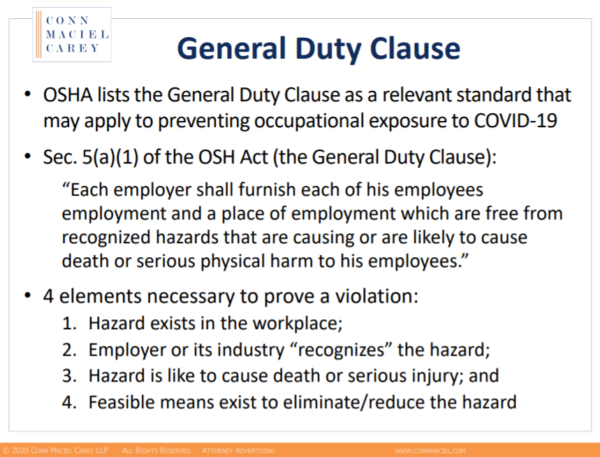A free webinar, “COVID-19 Updates for Grain, Feed and Processing Industry: OSHA Guidance and Workplace Health and Safety Issues," was hosted on May 20 by the National Grain and Feed Association and Grain Journal magazine. The webinar was presented by Eric J. Conn, a founding partner of Conn Maciel Carey and Chair of the firm’s national OSHA Workplace Safety Group. The following information is directly from Conn's presentation.
COVID-19 and the General Duty Clause
The General Duty Clause is the important context for understanding the Occupational Safety and Health Administration's (OSHA) expectations of employers for managing the OSHA implications of this virus in the workplace.
There is no specific standard, but there is the catch-all General Duty Clause, a provision of the Occupational Safety and Health (OSH) Act. It requires employers to furnish each of his employees employment and a place of employment that is free from recognized serious hazards.
COVID-19 is a global pandemic, so it clearly is a recognized hazard. Relative to some of its peer viruses, cold and flu and other coronaviruses, it has a high mortality rate, so it is certainly what OSHA would consider to be a serious hazard.
Thus, for OSHA to bring a General Duty Clause enforcement action, it must to establish that there is a feasible means to eliminate or materially reduce the hazard — to reduce the spread of the virus in the workplace. The ways that OSHA demonstrates that in essentially all General Duty Clause enforcement actions is by pointing to guidance of recognized, generally embraced, and feasible control measures that employers can implement to address the specific hazard at issue.
That guidance for purposes of enforcement in the context of COVID-19 is OSHA's own and Centers for Disease Control and Prevention (CDC) guidance. OSHA is collaborating directly with CDC to produce guidance in a workplace-specific (and sometimes industry-specific) format.
The cornerstone guidance is a document that OSHA issued on March 9. It includes OSHA's concepts for how employers should be assessing and responding to this unique hazard (COVID-19) in the workplace.
In the intervening months, OSHA has also issued numerous industry-specific and task-specific guidance. Although OSHA cannot technically enforce those guidance documents as though they are legal standards, through the framework of OSHA's General Duty Clause, it will feel that way to employers who neglect OSHA's guidance.
Click here to read the OSHA guidance → Guidance on Preparing Workplaces for COVID-19
Click here to view the full recorded webinar → NGFA Webinar: OSHA Guidance and Workplace Health and Safety Issues
Click here to view COVID-19 Resources prepared by Conn Maciel Carey's COVID-19 Task Force


